|
FAQs on the Ctenophorans, Scyphozoans and
Hydrozoans: Jellyfish Identification
Related Articles: Jellyfishes, Scyphozoans, Hydrozoan Jellies, Hydrozoans, Cnidarians,
Related FAQs: Jellies
1, Jellies 2, Jelly Behavior, Jelly Compatibility, Jelly Selection, Jelly Systems, Jelly Feeding, Jelly Disease, Jelly Reproduction,
|
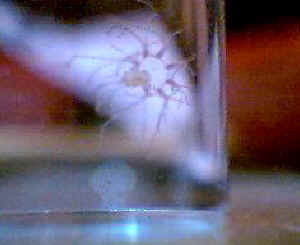
|
|
Salt water critter ID 7/22/19
Aloha, Mr. Fenner and staff, I have a 125 gal saltwater tank. The tank has been
up and running for almost a year. I have a very little clean-up crew and have
added four corals to the system about 1 month ago. yesterday I noticed little
white pinhead dots on the tank glass. They do not feel hard and have tentacles
(?) that move with the water flow. I did have a white cloud algal bloom that was
taken care of with a few small water changes, but other than that all of my
water qualities have been spot on. please see the attached photos. Thank you for
all of your help. Michelle Nason
<Looks to be some sort of Medusoid life... Hydrozoan, Scyphozoan Cnidarian or
Ctenophore; likely strobilation from part of the hard structure of your new
corals or live rock. Not likely problematical; will be sifted out by your
mechanical filtration. Bob Fenner>
|

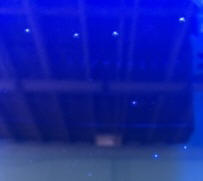 |
|
Re: Salt water critter ID 7/22/19
Thank you very much.
Michelle
<Welcome Mich. BobF>
|
Critter I'd? Help! 4/23/15
Hello! Kathy here once again. Thank you for all your awesome advice in the past
and I am once again in need of your expertise. So I have noticed these
REALLY long white tentacles sweeping all over my frag tank. When I took a
closer look, it looks like these long tentacles are actually coming from these
tiny little slimy / jelly blobs all over the glass. These little blobs
are stuck pretty flat all over the glass and protrude these really really long
tentacles and each of the long tentacles have smaller little tentacles
all throughout kind of like teeth on a comb. I have searched everywhere
and the closest thing I could find are the comb jellies
<Ctenophores was my guess thus far; perhaps Hydrozoans>
but I'm not sure if that's what it is. They are reproducing really fast and
there's at least 100 of them all over the glass and you can see the tentacles
all over the tank. Are These guys safe?
<Maybe not>
How do I get rid of them?
<Need to know what they are; but likely scraping, vacuuming and netting out
after scraped>
Please help!
PS each little blob looks just like a little wiggly blob. Not at all like the
comb jelly in Google images. Thanks again.
<Please send along a well-resolved pic. Bob Fenner>
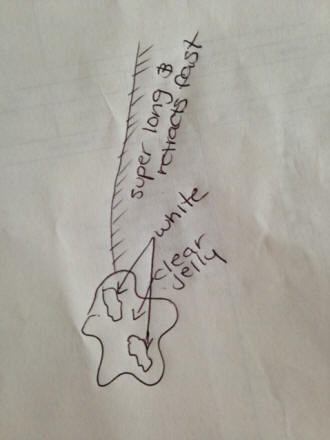
Re: Critter I'd? Help! 4/24/15
Hi again. I've been trying to get a good picture but can't right now. When I get
home later I can take a picture with a better camera. It's basically a clear
jelly like body with white inside and it's kind of divided in half.
This is a handwritten picture of what I see. Thanks again.
<Mmm; am changing my best guess to this being some sort of Hydropolyp
(Hydrozoan)... most likely undesirable. BobF>
Re: Critter I'd? Help!
Hello again! After lots of research I am leaning more toward ctenophores. I was
able to take a few out. They are actually green in color. It's AMAZING how LONG
the sweeping tentacles are. Here's a pic. Please tell me what you think. Thanks
again.
<Neat!>
|
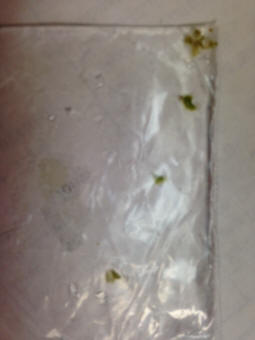 |
Re: Critter I'd? Help!
4/24/15
Sorry or the bother, this might be a better pic.
<Mmmm> |
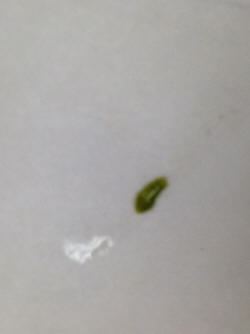 |
|
Re: Critter I'd? Help! 4/24/15
Last picture I promise.
<Still too blurry>
Now my question is, do you still believe they are ctenophores? Are they
harmful to corals? How do I get rid of them?
<See prev. emails>
Thanks in advance for all your help. I moved all my corals out just to be safe
but would really like to be able to place them back in as soon as possible.
Thanks
<Might be a Hydropolyp species... Not likely compatible. B>
|
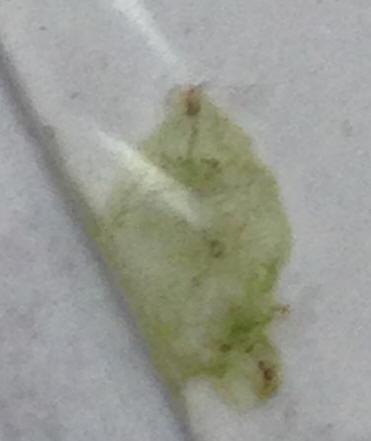 |
|
Jelly-Like Organism Identification Help
6/8/12
Dear WWM Crew,
Today I noticed a sizable number of tiny jellyfish-like organisms in the
sump/ outflow chamber of my 32-Gallon Finnex M-Tank. I haven't added
anything in over a full calendar year and it was established as a reef
tank nearly five years ago.
<Mmm, not uncommon... likely strobilized off the live rock... natural
reproductive event>
Additionally, I just moved the tank to my new place three weeks ago and
everybody seems to be doing very well. Some of the organisms were
"swimming" around in a manner reminiscent of a jellyfish's while others
were adhered to the glass surface, although they also would "swim" upon
being disturbed. I sucked a few of them up into a pipette and pipetted a
droplet of tank water, the diameter of which was a bit larger than that
of a quarter, onto a plastic 1 Gallon Ziplock bag which was laid over a
red piece of paper to make these clear organisms more visible (please
see the attached image and note the printed logo letters as a size
marker). What do you think they are?
<As you state; some sort of Medusoid life... Hydrozoan, Scyphozoan
Cnidarian or Ctenophore>
My guess was some sort of Hydrozoan or Scyphozoan, but I though I would
ask an expert. Also, do you think I need to be concerned about them?
<Not likely, no... will probably be mechanically filtered out...>
Thanks for your time and help and I look
forward to hearing from you.
Sincerely,
Gabby
<Oh, do read here:
http://www.wetwebmedia.com/jellyidfaqs.htm
Bob Fenner>
|
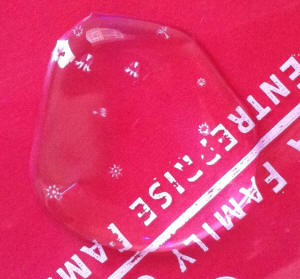 |
Re: Jelly-Like Organism
Identification Help
6/8/12
Dear Mr. Fenner,
Thank you for taking the time to answer my e-mail, I do appreciate it. Also,
I actually read that page prior to e-mailing you, which I then used to make
my amateur ID attempt. Many of the photos posted on the link you referenced
(http://www.wetwebmedia.com/jellyidfaqs.htm ) had similar qualities but they
also looked a bit different, so I figured I would send my own e-mail.
Anyways, thanks again for the opinion and your pages on WWM have been very
helpful as always.
Sincerely,
Gabby
<Welcome. BobF> |
|
Identify 10/15/11
Saw this on the glass today and all over the overflows. Hope you
can help with identification. Thanks
<Mmm, appears to be... soft bodied, radially symmetrical... a
"jelly" of some sort... Read here: http://wetwebmedia.com/jellyidfaqs.htm
and the linked files above. Bob Fenner>
|
|
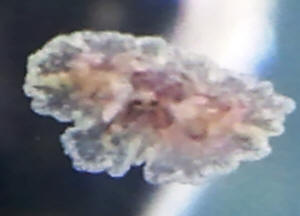
|
|
Colonial Anemone/Parazoanthus? 12/22/10
Hi Crew,
<Howdy Jim>
So far I have had my tank (29G reef) set up for about a year now.
Despite some algae and pH problems which I'm working to get
in-line everything seems to be doing well. I have used your site
for a reference for the past year and so far it has been a great
resource and I haven't had to ask any questions directly up
until now (thanks!).
<Welcome!>
It seems that every week or so I still notice something new in
the tank.
Lately I have seen 3 colonies of these "polyps" in my
tank. From some research on your site and elsewhere, the only
conclusion I can come up is that they are some kind colonial
anemone or Parazoanthus.
<Mmm, am pretty sure these are Aiptasiids... the family of
Glass Anemones.
Please see here:
http://wetwebmedia.com/marine/inverts/cnidaria/anthozoa/aiptasia/aiptasiaidfaqs.htm>
They don't seem to respond to changes in light like a tube
worm, although when I prod them with an object they seem retract
into their rigid tube. They are only a few mm wide and long.
<Oh! Small thus far>
Do you believe these will become a problem if they start
spreading throughout the tank?
<Could be if they begin to squeeze out other life, perhaps
stinging your livestock>
Should I remove them, or just monitor them for now?
<If not too numerous... I'd just watch/see. Do see the
related links above the citation re controls of various
sorts>
Please see attached photo.
Thanks,
Jim
<Welcome and happy holidays. Bob Fenner>
|
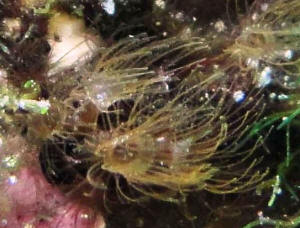 |
Re: Colonial Anemone/Parazoanthus? 12/22/10
Hi Bob,
<Hello again Jim>
Thanks for the prompt response! I had thought they might be
Aiptasia at first, but from my research I thought I remember
reading somewhere that these creatures don't retract into a
tube, but when they retract, they usually retract their whole
body into hiding (making them hard to get at).
<Yes and yes>
The ones in my tank definitely leave a visible tube behind after
retracting so it is the only thing that made me doubt they were
Aiptasia.
<Me too if so>
I will monitor and take action if necessary.
<Okay!>
By the way I have a copy of your Conscientious Marine Aquarist
and found it also to be a great resource. I wish I would have
just followed your advice from the book regarding the size of the
setup. I think a larger tank would have just been easier from the
beginning (despite the objections from the wife!).
<Heeee! Woulda coulda shoulda. Perhaps a "trade of
sorts" w/ your spouse.
Is she opining re something she'd like...?>
Happy Holidays and thanks again,
Jim
<Oh Jim! These may well be Hydrozoans/Hydropolyps based on
morphology, size, tube-dwelling habit and withdrawing behavior.
And to you and yours. Cheers,
BobF>
Re: Colonial Anemone/Parazoanthus? 12/22/10
I hope not!
<Heeee! If fishes were wishes, we'd all have full
tanks!>
I even thought about Hydroids; I just wasn't aware that they
also could withdraw into a tube. They are definitely colonial in
nature and so far I see three colonies in the tank, with this and
another appearing most recently. The third has been around for at
least two months and has about 12 members.
<Mmm, but not in one patch/batch...>
For what it's worth, I was taking a look at them again and I
noticed some worms and even my peppermint shrimp touching the
polyps (causing the polyps to retract) and none of the animals
involved seemed to recoil in pain.
<Good>
They also don't seem to be connected like I have noticed in
some other hydroid pictures but I'm not sure if this is a
prerequisite or not.
<Solitary Zoanthids are rare>
I only came to the conclusion that it might be some kind of
Parazoanthus because the tentacles seemed to be long and
"stringy" as compared with some of the other pictures
I've seen of that genus. Then again many Hydroids seem to
share this trait as well.
<Yes>
I will definitely keep an eye on them. Thanks again. You and your
crew do an awesome job.
Jim
<Glad to share. BobF>
|
Re: Colonial Anemone/Parazoanthus?
12/30/10
Hello again Bob,
<Hi Jim>
After a little more investigative work, I think I may have
found what these creatures are (at least narrowed it down a
bit).
I first found something that looks fairly similar (although
not exact) on this link here: http://www.masa.asn.au/masawiki/index.php/Nausithoe
The author there describes it is a Nausithoe.
<Ah yes>
I also found a reply from Ron Shimek on another forum:
http://forum.marinedepot.com/Topic46856-11-1.aspx?Highlight=id
He states, in reference to one of the images there that:
"The four-lobed nature to the mouth is clearly
evident, and that means that they are scyphozoan
polyps"
<This is so>
I attached the original photo with the mouth circled and
you will see the resemblance.
Just thought I would share my findings.
Thanks again and have a happy New Year!
Jim
<And to you! BobF>
|
|
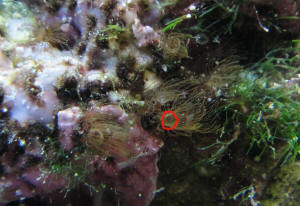 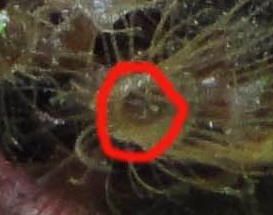
|
|
|
Trying to identify -- 02/02/10
I have a 120 gal seahorse tank that has been established for over
a year. I spotted two of these critters and would like to know
what they are. I suspect either hydroids or jellyfish.
<It's hard to ID to any degree of accuracy from photos
like this, but they look like jellyfish to me. Neato.>
I have removed them from the tank but I would like to know what I
am dealing with.
<I wouldn't worry about them. I don't think
they're hydroids. It looks like one of those things that, at
worst, might have a population bloom, then disappear.>
Thank you, Sue
<Best,
Sara M.>
|
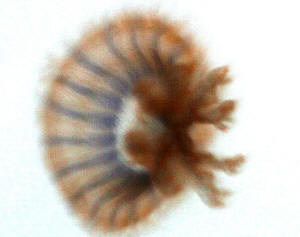 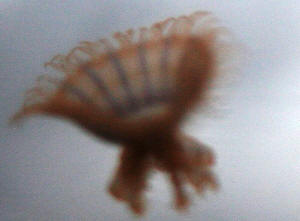 |
Blue Jellyfish, ID, sys. 1/14/10
Hello I would like to first start off by saying I am a newfound lover
of the marine aquarium hobby. I love it and have proceeded rather
quickly at it as well...
<Welcome to our wonderful, seemingly all-encompassing
avocation>
I have had several fishes die unfortunately due to a very fast start
and learned my lesson. I am the owner of 3 tanks and have put in a
fourth tank containing blue jellyfish. My jellyfish are using matured
water from my another stable system, ammonia and nitrites at 0. They
are running right now a cascade filter. 25 gallon tank with a 50 gallon
cascade. I want to know several things, right now I cant get my camera
to work but would like to send you pictures for ID as to know if they
sting/swim or what not.
<And I will in turn send them on to friend Jim Stime of Jelliquarium
for his help>
Next I need to know what kind of filtration needs they might have,
further than the cascade that is. I can get several items as I have a
pretty good supplier, but I do live in Costa Rica,
<Ahh! I have visited there a few times... San Jose, the Guanacaste
area, even out to Limon. A great, progressive country in my
estimation>
so availability and pricing are not the best. Also my jellyfish which I
have had for a day seem to float at the top of the tank, right at the
water level. I want to know why they stay at the top, they seem to be
able to swim when they want to, they just choose to stay at the top.
Not stuck in a corner because they move when they want to, just there.
Is it lack of circulation, what can I use to correct this?
<Am going to send this letter on to JimS and have him respond. He
knows MUCH more than I re these jellies practical husbandry>
Please let me know as I have several species here that I really like
and I have had a hand pick selection including a wartskin angler that I
need ID on (black with orange dots and rock colored spotting), I think
commerson frogfish or maybe fancy frogfish, clown trigger,
<!? A bruiser.>
Humu Humu and a few others. Please help me with these jellyfish quickly
so they can survive, I can get them Artemia to start, I have some
actually. Then if you can help me with the rest I would like that as
well but the others are doing fine now, its the jellies I'm worried
about.
Thanks for your time.
<Jim, please respond directly and back to me. Bob Fenner>
Re: Blue Jellyfish, hlth. 1/14/10
What is a bruiser?
<The Clown Trigger!>
The black frogfish I asked you about? Anyways I'm really worried
about the jellies, 2 are now at the bottom of the tank and 2 are at the
top of the tank just floating, I dont think I see them moving, I might
be wrong. They look slimy. like they are releasing some slime I mean...
can you please help me so I can see if I can get them to be ok?
<How? Sans pix or data? Please read here:
http://wetwebmedia.com/jellyfishfaqs.htm
and the linked files above>
Also do you have time to just look at the pictures of my fish and help
me identify them?
<... perhaps>
I would really appreciate that. Oh, one more thing, how do you feel
about yellow frilly scorpion fish?
<See WWM re>
worth $500 (and keep in mind that fish are expensive here, $200 for my
clown triggerfish, and that was wholesale, $300 at the aquariums). What
else can you tell me so I dont get myself stuck in the predicament I am
in right now with the jellyfish. I dont want these animals to die,
first and foremost I love sea creatures and dont want to kill them,
second of all I spent a hundred bucks a pop for these jellies. help
please....
ps.. I appreciate you looking out for assistance so you can help me
better. Thank you and your friend.
<? Keep reading. BobF>
Re: Blue Jellyfish 1/16/10
Hello Xavierhe and Bob
>> containing blue jellyfish. <<
Most likely Catostylus mosaicus or the Blue Blubber
>> They are running right now a cascade filter. 25 gallon tank
with a 50 gallon cascade. <<
What is a cascade filter?
>> if they sting/swim or what not. <<
In my experience I have NOT felt any sting, but I am sure they have
some ability. Best to use gloves when handling any jellyfish
>> Next I need to know what kind of filtration needs they might
have, further than the cascade that is. <<
Simple standard biological filtration, similar to a regular aquarium. I
see a competitor of mine is using a simple bowl/ sphere with an
undergravel filter.
>> I can get several items as I have a pretty good supplier, but
I do live in Costa Rica, <<
These are OK to start with but I do not know of anyone who has had long
term success with these. Generally if you can keep them for six months
you will have done well. It is believed that they are photosynthetic
and their mouths receive their food via 'radial canals' within
each of those 'lobed' tentacles. This I believe means its very
small food items, possibly copepods. I have tried several times to keep
these jellies myself, all without success.
>> Also my jellyfish which I have had for a day seem to float at
the top of the tank, right at the water level. <<
Assuming you just received the jellies its possible they have not
acclimated to your salinity, hence they are buoyant.
Personally I am avoiding the tropical species due to their difficulty
and working with the temperate Moon and Sea Nettle species.
Jim Stime, jr
805-241-7140
Aquarium Design - Installation and Maintenance
MyFishTank.com - Acrylic Aquariums and Quality Aquarium Furniture
Midwater Systems - JELLIQUARIUM Jellyfish Display Systems
LA Fishguys - Aquarium Reality Television
Thanks much Jim. Hey, are you thinking of attending Interzoo this year?
Can you maybe even slide in a week ahead of the May event to do a bit
of diving in the Red Sea?
BobF
Re: Blue Jellyfish
Hi Bob, going to one of those shows would be awesome, especially going
to the Red Sea... but I really cant afford to take time off work ( I
backed out of that free trip to Kona this month and I am doing
out-of-town jobs to fill in for the locals I've lost ) and I
don't scuba, yet... but I heard from a service customer who went
there and snorkeled and saw lots of stuff.
Jim Stime, jr
<Ah my friend. Remember years ago my urging you to take off at least
once a quarter... I do hope we both live long enough to get out MUCH
more often. Cheers, BobF>
|
Hydrozoan medusae: mystery solved? --
10/31/09
Hello Dear crew,
I just wanted to share a bit of a mystery that kept me going
crazy for many months.
<Oh! Please do>
There were two observations that I could not resolve with regard
to identity. First, I kept seeing these little jelly fish-like
creatures that occasionally appeared in my reef aquarium, and
that mysteriously disappeared after a while. Second, there were
these other creatures that looked sort of like little worm
dusters, but clearly there were not dusters as they did not
retract their crown when disturbed. After staring and poking into
my aquarium for many months, and searching to no avail, I think I
have it! The jelly fish are the
medusa stage of a Hydrozoan, and the "feather dusters"
are the mature stage of the Hydrozoan (please see attached
pic)!
<Nice work>
Please correct me if I am wrong.
<You are not wrong>
I am delighted that I seem to have finally made an ID, but of
course not that happy that I have
hydrozoans all over my rocks. Is there anything that eats
them?
<Mmmm, not specifically, no>
I do not want them to sting my corals!
<Best to keep filtering them out... eventually their source
will be exhausted>
In any case, I just wanted to share the pictures as I could not
easily find the info in the web, and it took quite a bit to reach
the above conclusion. I hope this can be of help to others,
having mystery jelly fish roaming their reefs.
Best,
Vivian
<Thank you for sharing! Bob Fenner>
|
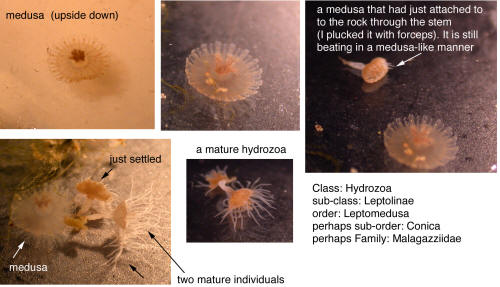 |
|
Found about 100 of these pulsating mushroom like
things in my aquarium 9/2/09
No one locally has any idea what these are. They are about 1/8
inch long and swim exactly like a jelly fish. I collected about
100 in a breeding trap. Saw a Banggai gulp one in and immediately
spit it out.
Any ideas?
JACK AGLIATA
<Are "jellies" of some sort... Scyphozoans,
Hydrozoans, Ctenophores... I'd be netting them out and
tossing or putting in their own system. Too likely to sting your
other life, possibly toxify the system. Read here:
http://wetwebmedia.com/jellyidfaqs.htm
and the linked files above. Bob Fenner>
|
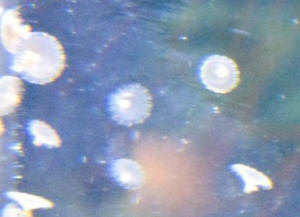 |
re: Found about 100 of these
pulsating mushroom like things in my aquarium 9/2/09
Thanks for quick reply.
<Welcome Jack>
Tank has been set up over 2 years so the appearance of jellyfish
now is surprising. There was one picture in the link you gave me
that was close. I have been told that some coral reproduce with a
medusa stage
<?! What the? No. These are strobilized...>
but have not found which species. I will pursue further from the
links therein.
THANKS
JACK
<Real good. BobF> |
|
Need help in identifying this organism
8/16/09
WWM Crew,
<Daniel>
I am dealing with a newly established (1.5 months) reef aquarium
containing 75 lbs of live Fiji rock, two Astraea snails and two
blue legged hermits.
While doing a daily scan looking for new aquatic life, I noticed
an organism (see photo) attached to the front glass of the
display tank. I thought it might be some type of jelly fish
<Yes... a Hydroid... Medusoid... versus a Scyphozoan...
Cnidarian>
but was unsuccessful in making that determination. Could you
please help me identify this organism and is it/will it be
harmful to my aquarium in the future?
<Can be... if too numerous or there is small life you'd
like to keep in the same system... e.g. very young/bred
fishes>
The water quality is as follows:
pH 8.2
Ammonia 0
Nitrite 0
Nitrate < 5ppm
KH 196ppm
Calcium 360ppm
Phosphate < .5ppm
Specific gravity 1.023
Temperature 80 F
If I can provide any further information please let me know Thank
You
Daniel
<Not likely a worry... can be re-occurring... from
strobilization off of material on rock... but not trouble unless
too numerous. Bob Fenner>
|
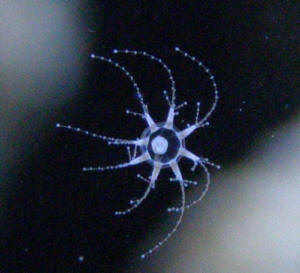 |
|
Looks Like An Octopus: Likely Hydromedusae - Cladonema
spp. 6/7/09
<Hello Brad, Lynn here today.>
I have little creatures on my tank walls that look like tiny
octopi.
<Neat!>
They have eight legs and just sit there for the most part. If
they do break away from the wall (on their own, not with my
assistance) they don't move in the water column, they just
freefall until they collide with something. They then attach to
that. Can you help me identify these animals?
<I'd need a photograph to confirm, but your drawings
certainly help! I'm guessing that what you have are
Hydromedusae, likely a species of Cladonema. For more
information, please see WWM, starting at the FAQ titled
'Please Help Me ID a Jellyfish-Like Creature: Hydromedusae -
Cladonema spp. 3/11/09' at this link:
http://www.wetwebmedia.com/jellyidfaqs.htm >
Thank you for your time, Brad
<You're very welcome. Take care, LynnZ>
Looks Like an Octopus: Likely Hydromedusae - Cladonema
spp. 6/7/09
<Hello Brad, Lynn here today.>
I apologize; this is my second e-mail to you.
<No worries>
I realized that I wanted to include a picture. I hope this
helps.
<Yes, indeed, thank you!>
I have little creatures on my tank walls that look like tiny
octopi. They have eight legs and just sit there for the most
part. If they do break away from the wall (on their own, not with
my assistance) they don't move in the water column, they just
freefall until they collide with something. They then attach to
that. Can you help me identify these animals?
<I'd need a photograph to confirm, but your drawings
certainly help! I'm guessing that what you have are
Hydromedusae, likely a species of Cladonema. For more
information, please see WWM, starting at the FAQ titled
'Please Help Me ID a Jellyfish-Like Creature: Hydromedusae -
Cladonema spp. 3/11/09' at this link:
http://www.wetwebmedia.com/jellyidfaqs.htm >
Thank you for your time, Brad
<You're very welcome. Take care, LynnZ>
|
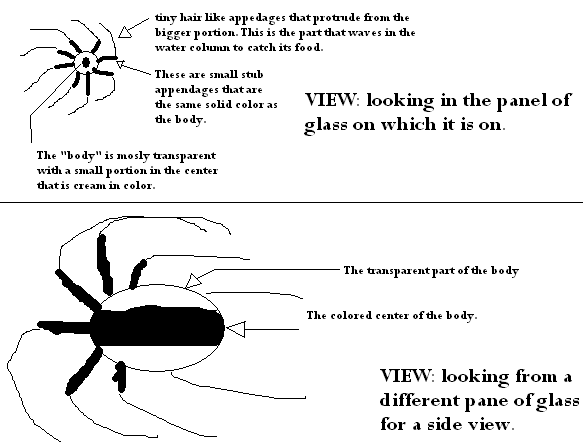 |
Hydromedusae or Staurocladia Maybe 5/14/09
I just want to say you guys are incredible and have given me a lot of
value information in the past and was hoping you could help.
<Will try>
A friend recently found a small Jellyfish in his reef aquarium and
asked me if I could Identify it. Off the top of my head I could not
tell the exact species. It appears to be a type of hydroid but I am not
exactly sure.
<There are several species... some quite similar in gross
appearance>
I spent a few hours searching and could not get any specifics. It is
very similar to the critter described in the first post I found with
you guys.
FAQs on the Ctenophorans, Scyphozoans and Hydrozoans: Jellyfish
Identification
Except that it is quite a bit larger, the bell measures 5mm wide and
6mm tall, roughly, and when the appendages are extended it exceeds half
an inch. Also the structure within the bell when viewed from the top or
bottom is in the shape of a star.
<Mmm, indicative more of true jellies (Scyphozoans), but
still....>
The structure appears to be composed of many spheres that stack 3
high.
It also is fairly red in color but does change when bothered.
<Neat!>
Also in the center on the bottom is a white dot. The appendages are
clear with white dots that I assume are the nematocysts. It has 8
appendages fyi.
<Mmmm>
Also my friend informed me that prior to his discovery of these little
jellies he did notice that his arms became itchy whenever he worked in
the tank (now he does not play in the tank).
<I'd be wearing gloves>
Is this a slightly different species or am I just crazy?
<Not crazy>
The picture attached does this jelly no justice.
Thanks for all your help!
Robb
<Can you send along a better pic? I'll send it along to ask
others in the know. Bob Fenner>
|
Please Help Me ID a Jellyfish-Like Creature:
Hydromedusae - Cladonema spp. 3/11/09 Dear Crew, <Hi
Mike, Lynn here this evening.> I am a long time freshwater
aquarist, who has recently delved into the saltwater world.
<Neat!> I have scoured the internet trying to identify the
jellyfish-like creatures that I have in my tank of clowns.
<Okay> They appear to act like a jellyfish; <For good
reason!> ...there are hundreds of them in my tank. They
primary sit on the bottom of the tank looking clear and bell
shaped with a beige colored column in the center, they have 9
appendages with tiny hair like extension. At other times they
attach themselves to the glass. When on the glass you can clearly
see the appendages and the hair like extensions. The largest is
1/8 inch in diameter to the end of the appendages, not counting
the hair like extensions. If a baby brine shrimp drifts into the
extensions it is quickly caught and dragged to the center of the
appendages and consumed. They propel themselves by compressing
the bottom part of the bell to expel water. They can move quite
quickly for a short distance. They then drift to the bottom or
side of the tank, like a parachute. <Terrific observations>
I am attaching photos and a short video to assist in the ID of
these creatures. <Excellent, thank you!> What are they?
<They're hydromedusae/jellyfish in the genus Cladonema.
Size is usually ~2-3mm. As you mentioned, they spend most of
their time either swimming about or clinging to the substrate,
etc. According to Dr. Shimek, they likely feed on 'small
copepods and particulate material in the water'. For more
information, please see the following links:
http://jellieszone.com/cladonema.htm
http://melevsreef.com/id/jelly.html > They don't appear to
have harmed anything in my tank. <Good!> Will they sting
like jellyfish <It's possible, yes. They have
nematocysts/stinging cells so they are capable.> ...and is
there any need to worry about harm coming to me or my fish?
<Unfortunately, I couldn't find anything conclusive as to
how 'safe' these are in a system with fish, but I
haven't heard/read of any horror stories either. Personally,
I wouldn't want to see them in a tank of clownfish (or any
other) fry, or baby seahorses, but other than that, I
wouldn't be too concerned. The general consensus seems to be
that they're 'mostly' safe. As to whether you could
get stung, I imagine you could, but I just don't know how
much effect it would have. It might be negligible unless you
picked up a handful of the little creatures, or were
allergic/sensitive to them. Again, I just don't know. I would
play it safe and avoid contact. If you are at all concerned, or
see any signs of livestock stress, I'd remove them/reduce
their numbers via a siphon or turkey baster. More than likely,
though, these jellies will stick around for a little while then
disappear.> Thanks for your help. Mike
<You're very welcome. Take care, Lynn>
|
[1].JPG) |
| Re: Please Help Me ID a
Jellyfish-Like Creature: Hydromedusae - Cladonema spp.
3/12/09 Lynn, <Hi Mike> Thanks, I also checked out
the website you referenced. Great info. <Excellent> Mike
<Take care, Lynn> |
Micro-spider 'pods? 2/22/09
I just set up a 90 gal reef system with about 120 pounds of live
rock.
I'm seeing the usual suspects as far as 'pods go, but I saw a
new one today:
about the same size as other tiny pods, but have 8-10 legs in a
starfish type pattern. They are about 1mm across, including legs, less
than .5 mm without legs. Baby stars?
<Maybe>
A type of 'pod I can learn about?
<Certainly>
Thanks,
Dan
<Photo/s please. Bob Fenner>
|
Re: micro-spider 'pods? 2/22/09
Thanks. My camera won't focus in closely enough. Looked
through everything I could find on your site (plus others), so
I'll probably just have to live
with the mystery. Appreciate the time.
<Welcome Dan... do keep your eyes peeled for someone with a
"close up" feature on their small digital camera... A
common feature now a week!
BobF>
Re: micro-spider 'pods? 2/22/09
Best I could do (attached). Thanks for the idea...I'll keep
my eyes peeled.
<Ooohhh, this looks a lot like Staurocladia. Please scan
here:
http://wetwebmedia.com/jellyidfaqs.htm
Bob Fenner>
|
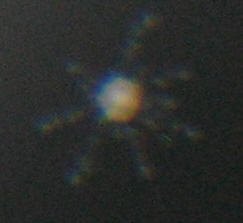 |
Re: micro-spider 'pods? 2/22/09
BINGO! Thanks, and have a good one.
<Ahh! You as well Dan. BobF> |
|
Help ID'ing this critter! 1/19/09 Hi
Crew, I have seen about four of these guys in my tank in the last
two months. It looks like a very tiny jellyfish 1-2 mm in width,
bell shaped and when in the water column it is free swimming with
a pulsing kind of motion. <Are medusoids... of some sort> I
have attached some pictures of one I scooped from the tank, it is
in a clear plastic bowl lying on a towel, (that is the hairy
material in the background). I also managed to capture a video
clip of it swimming in the water column here
http://s464.photobucket.com/albums/rr2/KKamysek/?action=view¤t=MVI_0222.flv.
<Neat!> While it was free swimming, my Banggai Cardinal
chomped on it and quickly spit it out, making me think he got
stung (or maybe he just didn't like it). The closest
reference I can find is it may be Cassiopeia Andromeda in
reproduction mode? <Mmm... doubtful... do you have these in
your system as adults?> Is it detrimental to my reef? <Mmm,
they could be... as you postulate above re apparent
palatability...> Should I be getting rid of these guys when I
see them? <If too numerous and/or you see your other livestock
suffering from their presence... Likely are strobilizing from
some hard surface (e.g. live rock)... could be Scyphozoans,
Hydrozoans, even Ctenophores... Please see WWM re. Bob Fenner>
Thank you,
Karl
|
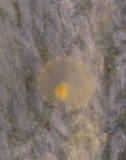 |
| Another New Critter - 7/2/08 Crew,
<Jared> I found another critter today that I have actually
seen before, but have never been able to get a good photo of. I
have a few of these in my tank, and they are either swimming or
attached to the glass. <Ah, yes! Was out for dinner at a friends
last night and they played some of the excellent "Blue
Planet" series... part of which featured some great footage of
strobilization...> They are about the size of a pea,
disc/umbrella shaped, and "pump" their bodies while they
swim AND when they are attached to the glass. I thought they were
some kind of jelly, but I haven't been able to find a picture.
The attached photo isn't the best, but I think you can get a
good idea. Thanks again, Jared S. <Is indeed a jelly... There is
but a small bit re their appearance, concern posted on WWM. Please
do relate further observations you have re. Bob Fenner> |
|
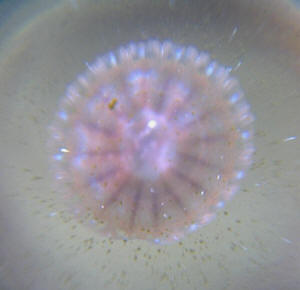
Re: Another New Critter... Jelly! 7/3/08 Bob,
<Jared> Thanks for the info. I searched WWM today and found
a post from Jim Stime regarding Moon jellies. The photos he
posted of the juvenile Ephyra matched nearly perfectly to what I
have in my tank. <Ahh!> I actually have some of the polyps
on my rock, and I am guessing since I don't have the correct
tank for jellies, the ones that I see swimming don't last
long. I will try to take better pictures, but I think we may have
solved this one. Thanks again Bob... Jared S. <Thank you for
sharing. BobF>
|
|
Scyphozoa Question 6/16/08 Hi, <Greg> I have
discovered that I have what appears to be several jellyfish
(Scyphozoans) in an aquarium I use for experiments. <I saw a
bunch of settled Ctenophores in shops this last wknd. in Phoenix.
Okay, your turn> The system (less than 1 gallon) is unfiltered
with no outside inputs except for a very small amount of air from
an air stone. I had ordered some rotifers about a year ago and
placed them in the system. <Ahh!> They did not last very
long. I cleaned off some algae from the side of the system
recently and noticed jellyfish that are about 2 mm maximum in
size. I am assuming jellyfish eggs or planula came in the
rotifers batch I received last year. <Likely so> Their
locomotion is identical to larger jellies. They have a
clear/translucent bell, some reddish/maroon color inside the bell
and translucent tentacles or oral arms. <Neato> Have you
ever heard of captive jellyfish outside of a large institutional
(city/corporate) aquarium? <Oh yes... in fact, a friend, Jim
Stime, makes/sells Jelliquariums... and I saw some very nice,
much cheaper models a couple weeks back at the Interzoo show in
Germany... it's a biz> Do you know of sources I could use
to identify these guys? <Mmm... am referring you to Jim Stime
here... you can also reach him via Jelliquarium (.com)> I
cannot provide a picture easily. They are too small for my camera
equipment. <Macro settings, large file size... cropping...>
-- Thank you, Greg S. Hurley <Ahh! Had a fine H.S. Geometry
instructor with your family name here in San Diego... years back!
Cheers! Bob Fenner> Re: Scyphozoa Question
6/16/08 Hello Gregg and Bob, The jellyfish portion of the
hobby is just now becoming possible. As such there is very little
information available... but its increasing. I have kept, for
only a short time, Ctenophores, but have not been involved with
their reproductive cycle. Moon jellyfish are the most common and
have the greatest amount of research and information available.
These are the pale white discs with short fringe tentacles around
the rim and the familiar four-leaf clover pattern within the
bell. Most jellies have a polyp stage where the medusa
strobilates or a-sexually buds off from the oral disc portion of
the polyp. Once the juvenile has freed himself he is now called
an Ephyra. It takes another 60+ days to raise these jellies to 2
or 3 inches. Here is a short video of my jellyfish production
system >>
http://www.lafishguys.com/midwater/JellyNursery001.htm <<
Based on your comment about " some reddish/maroon color
inside the bell " I suspect what you are either seeing the
food stuff brought up into the stomach of a Moon jelly species or
you may possibly have a species of Sea Nettle, Chryasora species.
These tend to have much longer tentacles... and ones that sting
too. Aside from the Upside-down Jellyfish all other species
typically require a tank that keeps the jellies suspended once
they have bud-off from the polyp. Here is an article I wrote on
the process >>
http://www.jelliquarium.com/DocumentPage.aspx?id=1034 <<
There are only a few good books available on jellies. Most are
written for 4th graders. Let me know if I can help you further.
Jim Stime, Jr. 805-241-7140 Aquarium Design
www.aquarium-design.com MyFishTank.com www.myfishtank.com
Midwater Systems www.jelliquarium.com LA Fishguys
www.lafishguys.com <Ahh! Thank you Jim. BobF>
Re: Scyphozoa Question 6/16/08 Hi Bob, >>
I saw some very nice, much cheaper models a couple weeks back at
the Interzoo show in Germany... << Can you tell me anything
about these systems ? <I picked/saved up some lit to give you
I picked up... just got to find it again!!! BobF> Jim Stime,
Jr. Most impt.... they were very nice... and cheap... like about
a fourth of yours in cost... Trouble if they're offered in
your mkt. for shore. B.
Re: Scyphozoa Question 6/16/08 Bob and Jim, <Mr.
H.> Thanks for the info. I think I might have to get into
jellyfish. Sounds like a fun new challenge. <Are indeed>
Thank you, Greg S. Hurley <Welcome Greg. BobF>
|
|
Need Help With An ID No One Knows In My Reef
Forum 2/24/08 <Hi Jim, Mich here.> I bought snails from
the LFS and on 1 of the shells was this aiptasia looking thing,
that's what I assumed until it released itself and started
swimming. It swims like a octopus flailing its tentacles I've
posted on a reef forum and looked all over the Internet
researching this thing but have come up with nothing. Any help
would be appreciated. <Looks like a hydroid jellyfish to me.
More here:
http://www.ronshimek.com/Animal%20Groups%203%20Cnidarians.htm
http://www.wetwebmedia.com/jellyidfaqs.htm > I do have it in a
catch bucket but was wondering if it's safe to put it in my
reef. <Likely wouldn't hurt. Populations tend to wax and
wane. Is interesting to observer for sure.> Thank you for any
help you can give me. <Hope this helps. Mich>
Jim
|
|
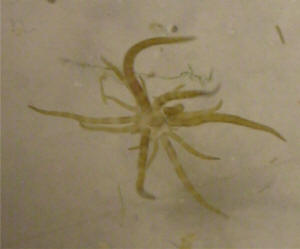
|
|
Id: Staurocladia oahuensis - 10/16/07 Hi,
<Hi there, Ben> This tiny little fellow, about 50
thousandths of an inch across, is presently adhered to the front
of my tank: http://www.flickr.com/photos/fyngyrz/1573547118/
<Nice photo!> He looks like a baby anemone of some kind to
me. Any of you recognize the lil' fellow specifically?
<Heeeeee, well, not that one specific individual, but I do
recognize the specie: Staurocladia oahuensis. These are tiny
crawling hydromedusae, also known as hydroid jellyfish, and are
generally not a problem. They typically wax and wane in
aquariums, sometimes appearing in great numbers, only to
disappear a short time later. Please see these links for more
information re: http://www.wetwebmedia.com/jellyidfaqs.htm
http://www.ronshimek.com/Animal%20Groups%203%20Cnidarians.htm
> --Ben
<You're very welcome! --Lynn>
|
|
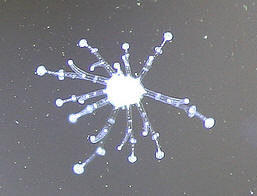
|
| Baby Mini Brittle Star? Nope, Hydroid Jellyfish!
8/19/07 I was wondering if this was a mini brittle star.
<Nope, it's a teeny tiny crawling hydromedusae (Staurocladia
oahuensis) and generally nothing to worry about. Please see these
links for photos and more information:
http://www.wetwebmedia.com/jellyidfaqs.htm
http://www.ronshimek.com/Animal%20Groups%203%20Cnidarians.htm
<Take care -Lynn> |
|
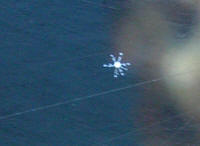
|
|
ID question: ovoid pulsating 3 mm animal in fuge 5/30/07
Hello to all the crew! I would be very curious to know what this
is. Very intriguing. It's about 3mm in diameter and moves in
a pulsating way in the water column. It never settles on the
substrate. It's a very slow flow fuge. The way I see it, it
wouldn't last long in the display. For what I know it's
been there for the last three days and never noticed something
like that before. I didn't add anything in the last few
months. <Are strobilizing from some hard media...> I am not
worried, just very curious. Here are 4 pictures. There are SPS
and LPS in my thank as well as sponges (hitchhikers). Could it be
the larval stage of a coral. I guess not given the size (3mm is
somewhat big). Thanks in advance!!! Dominique <Looks to be a
Ctenophore to me... A Comb Jelly... Bob Fenner>
Re: ID question: ovoid pulsating 3 mm animal in fuge --
5/30/07 Thanks a lot Mr. Fenner! Puts me on the right track,
will be doing searches with this... Dominique <Really neat
animals... and always reminds me of one of fave H.S. teaching
jokes re the Radiata (group including the Cnidarians and
Ctenophores)... "Hold old are most Comb Jellies?"...
"Most are in their "teens"" (as in "Teen
Oh Phore"). No groaning now. BobF>
|
|
.JPG) .JPG)
|
| Staurocladia oahuensis (hydroid jellyfish)
03/25/07 Hello Crew, <Hi.> I browse your site extensively
and read just about everything on it. <Awesome.> I have tried
searching through your site and have not found what I'm looking
for to this particular creature. see attached). <Appear to be
Staurocladia oahuensis (hydroid jellyfish). Generally speaking they
are readily consumed by most life forms in marine
aquaria....similar to the plight of other
microcrustaceans/copepods. There populations seem to go and come
with little consistency. I would not worry.> The pic was taken
through a magnifying glass with the camera on the close up setting
so unfortunately, it doesn't get better than this. <No
worries, was able to I.D.> 125 gallon 6ft long 3" DSB Sump
that is in process of becoming refugium <Good.> Porcupine
puffer (2") <A baby! Will grow quickly...> Dogface
puffer (5")Diamond goby Fire Shrimp assorted snails and
hermits~50 <Careful with the goby and hermits both could wind up
being puffer lunch.> lbs LR Mail ordered shaving brush plants
LFS bought Chaeto in sump I have tried looking through pics of a
copepods life cycle and it doesn't resemble this. Some of these
creatures have 5 "arms" others appear to have 8. If
anyone has an idea I'd love to hear it. Also I keep reading
that there are web sites devoted to determining kinds of animals,
after an exhaustive search through Google, I cannot find one that
offers crisp pics of organisms through there life cycles. Any ideas
on this also? <There are a multitude of sights dedicated to
helping hobbyists with these types of issues, they are difficult to
find though if yo don't know where to look. I would suggest
asking the folks on our free chat forum:
www.wetwebfotos.com/talk....there is much posted re: this
issue.> <Adam J.> |
|

|
| What The?!...A Tiny Hydromedusae - 01/17/07
Tara here, <<Hello Tara...Eric here>> Ok I've
searched and searched. <<ME TOO!...ummm...what are we looking
for?>> Here on your site there have been two different
answers to this question. <<Ah, a 50-50 chance of being
right...better odds than most...>> But what are these?
<<Staurocladia oahuensis (hydroid jellyfish)>> The disk
itself is about the size of two male copepods. Look a little like
tiny brittle stars. <<Indeed they do...but they
aren't...at least not in my opinion>> They're all
over the glass in my zooplankton 'fuge. <<Nothing to
worry about/won't cause any problems...and will likely
disappear as quickly as they appeared. Study/enjoy them while they
are around. Eric Russell>> Tara |
|

|
ID this worm(?) please, and medusoid 1/17/06
Dear Sir/Madam, <Will you read my book? Oh, sorry, not one of
the Beatles here> I have my marine tank 29 gallon BioCube in the
5'th week of cycling. I also have about 28 lb of live rock and
about 2 lb of live sand. This past weekend I've added an 11
snails and 6 red-legged hermits. Snails took a very good care of
the algae on the rock... Everything seems to be looking perfect,
until I found some kind of worm(?) on the inside glass eating the
pods. <Mmm, yes... some sort of Platyhelminth...> I have an
extremely high pods population: when I clean the glass inside, they
will reappear within the same amounts in about 2-3 days. I'm
attaching a picture with 2 critters one on the top is an
unidentified one (length of about 3-4 cm) and the bottom the pod
that is about to be eaten. This thing on the top moves really fast!
I also noticed, that there are one that is splitting on the glass,
that looks like there will be another two instead of one soon. It
took that thing to split up about 5-6h. Thank you very much for
your time and effort in maintaining such an excellent site.
<Welcome... these are flatworms... I would just wait, let them
pass on their own here (likely will in short order... no need to
try and selectively poison...)> There are also something else
that I noticed today...I turned off my powerhead, and noticed those
little tiny thing (about 2-3cm), that move by pulsating. Looks like
jellyfish. Are these ones good or bad ? <Mmm, could be bad...
but likely will also go of their own accord... Are likely some sort
of tissue-grade life (Cnidarian, Ctenophoran)... that are arising
from a hard substrate...> Unfortunately I were not able to make
a good picture of it, but it is on the 2'nd picture... <I
see this... a medusoid of some sort... you can read about such with
a search of WWM, the Net... and the terms above.> Thank you very
much for all your help...Regards, Andy Stavickis
<Welcome. Bob Fenner> |
|
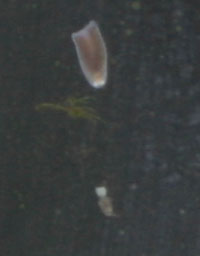 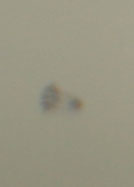
|
Medusae ID - 07/28/06 Thank you for getting back
to me about the use of these light strips. By the way my name is
Michelle. I forgot to add my name in my last email due to the stressful
situation I got into. <<Quite welcome Michelle, but I'm not
sure who your thanks should go to since you didn't include the
prior exchange>> I recently purchased about 4-pounds of live rock
from LFS on Sunday. I have it in my main tank curing with my protein
skimmer running 24/7 and it's going well for the curing.
<<Okay>> I have been up late every night looking at the
amazing life that's on it and have been using your website to help
identify a lot the creatures. <<Hee! What an amazing hobby,
eh!>> I'm currently having an issue with trying to identify a
new creature I found floating around my tank. It's shaped like a
bell, a dark creamy, clear color and it pulsates. It has a small
whitish spot on the top and has about four smaller whitish spots on the
very bottom. It's about the size of a pin head. <<Wow,
you've been doing some "close" observation
indeed!>> I'm using my daughter's magnifying glass from
her sea-monkey kit. <<Excellent!>> It's really too
small to photograph with my camera. I was wondering is there a link for
photo id's on jelly fish so I can compare it to the pictures. It
really is a cool critter. <<Mmm...is likely the medusae stage of
a coelenterate, the "whitish spots" you see are probably
ocelli...a light-sensing organ. This may or may not be a jellyfish
(though your initial description does sound as though) and I think a
positive ID is going to be tough, but you might just try a Google
search on the keywords 'Jellyfish Medusae' or even just
'Medusae' to see what you can find. It is not unheard of for
Cassiopeia jellyfish to make it in to aquarist's tanks via live
rock/coral additions, but I don't know that it will be possible to
identify as such at this small stage. You might also try a search on
the 'Moon Jellyfish'>> After finding this thing now my
husband is really interested saltwater tanks. <<Cool!>> I
was wondering is there a link that I can use to photo ID this critter.
<<Not that I know of just off-hand...do try the keyword
search>> Thank you again for your help. Michelle <<Happy to
assist...good luck with your search. Eric Russell>>
Jellyfish Surprise! - 5/11/06 Hello,
<<Howdy!>> I noticed something today in my aquarium,
it's a VERY small jellyfish looking thing. <<Neat!>>
It's smaller than a pencil eraser and swims in the current of my
aquarium. None of the fish bother it either. Is this normal?
<<Mmm, not "normal" in the sense that it happens all
the time...but not unheard of>> Will it bother anything?
<<Likely not, nor will it probably survive for long...enjoy it
while it is around>> Brian
<<Regards, EricR>>
Hydroid Jellyfish - 05/02/06 Dear Mr. Fenner,
<<Eric Russell here today!>> I have an infestation of
what appear to be tiny hydroids lining the walls of both my QT and
my main tank. <<Mmm yes, some of these just popped up in a
member's tank in my local club...is a tiny crawling
hydromedusae...Staurocladia oahuensis...nothing to be concerned
with>> I recently imported a rock of Ricordea, and some
Banggai cardinals. <<May have come with the rock>> The
fish I quarantined, the rock I didn't. I assume the rock had
the Hydroids on it, but I have many more hydroids in my QT.
<<Easily transferred in water/on equipment>> However, I
do use main tank water as replacement for my QT... so who knows
where these little buggers came from? <<Indeed...and under
optimal conditions they will multiply rapidly through asexual
budding or fission...just one can become hundreds...only to
disappear just as quickly>> Question: I hear these little
guys eventually "just go away"... is that your
experience? <<Yes>> Question: Do I need to tear down my
QT? <<I wouldn't for this, no>> I'm getting it
set up for a pair of clowns. Can hydroids injure fish? <<I
don't believe these to be a danger>> Russell in KY
<<Quite welcome, EricR in SC>> |
|
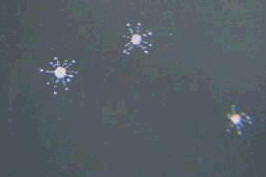
|
Comb Jellyfish 12/13/05 Hi Bob, <Jimbo> Quick
note. See attached picture <Nice> The jellyfish product line
keeps growing. I just received a shipment of Comb Jellies out of
Key West last week. <How old are most comb jellies? Most are in
their teens (Ctenophora)> Under the MH their fine rows of hairs
reflect the light in a UFO landing strip type light show. Awesome !
Jim Stime, jr. Resplendent Group Aquarium Design
www.aquarium-design.com MyFishTank.com www.myfishtank.com Midwater
Systems www.jelliquarium.com Centropyge.Net www.centropyge.net
MACNA X www.masla.com/macnax.html
<Beauty. Bob Fenner sans list> |
|
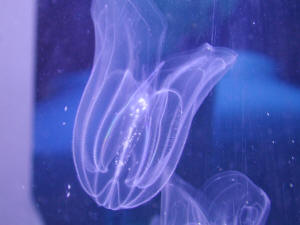
|
| Baby jellies... or some other creature? 1/4/06 Hi crew,
<Chris> Sheesh. I had to get creative to photograph these
critters. I snagged one with an eyedropper, placed it in a water
drop on a slide, and popped it into my $20 National Geographic
'scope. After removing the eyepiece shield, I was able to snap
a few photos of reasonable enough quality for ID purposes... I
hope. <Neat> These pics are slightly out of focus, but the
best I could get and still get the whole thing.
('scope/lens/user? limitations) I've seen some dozens of
these, over the past few days, in my 55G saltwater tank. I'm
seeing fewer lately, due to losses in my power heads and/or
filtration, I suppose. (Or predation?) <A combo. no doubt> I
didn't notice them today, until swishing around my LR with a
turkey baster... blowing off some food that had 'settled'.
(Perhaps these had 'settled' too... and I stirred them up?)
<Likely so> Anyhow, they look for all the world like
mini-jellyfish of some sort, though I couldn't imagine from
whence they came. My only recent addition is a 6" ball of
Caulerpa Racemosa from my QT. (Note that this QT also contains
assorted amphipods, worms, and other tiny marine life that has
accumulated over time) The Caulerpa had been in the QT for three
weeks. <Mmm, are some sort of medusoid life> Most are about
the size of this period. (Some are a bit larger) The photos show
the rest of my observation. At "rest", they're full
of water, their "valve" is closed, and you can see a few
small protrusions between the two dark spots at the valve end. To
move, they appear to expel water through the 'valve', and
they contract axially, while extending longitudinally. (Moving away
from the 'valve' end, of course) <Yes> Enough of my
rambling, I suppose. Please edit and ditch any irrelevant babbling
as you see fit. I won't mind. Do these look like anything
you've seen before? <Mmm, yes... juvenile
"jellies" of some sort (Scyphozoans, Hydrozoans) or
ctenophorans...> Feel free to whack me in the head with a book
of your choice, if these are something very common that I
should've found on a simple web search. (I looked, but perhaps
not hard enough) Tell me if you need more info, tank
specs/inhabitants, etc... Thanks in advance, Chris <I
wouldn't be overly concerned re these being in your system...
likely "strobilized" from the new algae... or some other
substrate. Will pass with time. Bob Fenner> |
|
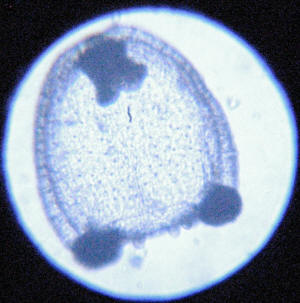 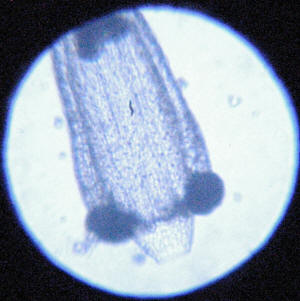
|
Tiny Jellyfish 2/23/06 Hi Guys! <Lesley> Hope you are
keeping well - it's been a while since I last contacted you so I
hope you are all ok. <I am, thanks> Two days ago, in the smaller
of our two marine tanks, I noticed three, tiny white jellyfish-type
critters - literally, the mushroom shape, but no tentacles - quite
"stiff" in structure and jerky in movement as opposed to the
more fluid, typical jellyfish. They were about 2mm - 3mm in diameter
and were "swimming" around the tank being ignored by the
fishy occupants. I think they're cute! Anyway, today, I counted 7
of these tiny critters, varying in size from about 1mm to 3mm across
the top of the "mushroom". I still think they're cute but
have no idea what they actually are or where they came from as we
haven't added anything new to the tank for several months. I
wondered if you could help. Sorry the description is so vague. Also,
they are too small to photograph clearly. Any light you can shed on
this would be most appreciated! Many thanks! Lesley Saxton <There
are quite a few Scyphozoan and Hydrozoan medusoid animals that can
strobilize from hard surfaces introduced in our marine systems... Use
these terms in your search tools... and you'll see. Bob Fenner>
Tiny Little Jellyfish Things ??? Bob, I have recently discovered
these tiny creatures in my marine tank, evidently they arrived on the
new piece live rock I inserted a week ago, I have not been able to find
out on the web what they are or identify them in any of the books I
own. I am hoping that you have a clue as to what these new species are.
The creatures have a round flat translucent top then a cylinder and
tentacles and are about 1 to 2 millimeters in size. They look like and
swim like little jellyfish constantly trying to reach the waters
surface. The fish in the tank seem to take no interest in them but do
swim around them with a wider berth then other things in the tank.
Thanks, Jason <almost certainly harmless or even beneficial. Many
pelagic marine planulae and medusae (as with jellies) look very similar
at young stages. If you have any Atlantic live rock or recently put in
snails or hermits from the Atlantic, then you may have the young
medusae of the non-stinging "Upside-down" jellyfish
(Cassiopeia). A photosynthetic and hardy creature if kept from pumps or
strong current (great fun and somewhat easy to keep in a fishless
seagrass refugium). At any rate... enjoy until it gets larger when it
can be better identified. With kind regards, Anthony Calfo>
| Oh No! Yep I said jellyfish I have come
across these jellyfish in aquarium stores many times. They are
small and colorful, usually a light blue to a white color. They
aren't very expensive either. I wanted to ask you a simple
question about them: Should I even try to keep one? Or are they
just a "gooey" form of the Moorish idol. I tried to do
some research on the internet and didn't come up with much on
husbandry. I did hit a lot of aquarium sites and learned vaguely
about the animal. Anyway I don't know the common or scientific
name of these jellyfish. I have included some pictures, could you
please identify them and tell me more about them. I fully
understand how the tank should be set up...I need to learn about
their eating habits though..... Thanks for all the help, Dinesh
<Looks like a mixed (dyed) group of Cassiopeia andromeda
jellies. Please see here re:
http://animaldiversity.ummz.umich.edu/accounts/cassiopeia/c._andromeda$narrative.html#food_habits
and
http://www.liveaquaria.com/product/prod_Display.cfm?siteid=23&pCatId=543
Not easily kept. Bob Fenner> |
|
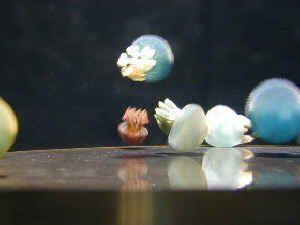
|
Question about jellyfish Hello, <Hi Bill and Donna!>
I'm a customer of Marine Warehouse in Tampa, Florida. During a
visit for a few items this evening we took along a sample of water with
items that look like tiny jellyfish that have begun growing in out 10
gallon salt. The folks there took a look and said "Those are
jellyfish and we've NEVER heard of them reproducing in a 10 gallon.
You should email Anthony Calfo or Bob Fenner at WetWebMedia and let
them know what's going on". These animals start out growing on
the rocks, then sort of "detach" themselves and, well, swim
around the tank like jellyfish--the size of a bb or so. <Wow! This
is one of my favorite things about this hobby! There are several
possibilities here. Some hydroids have a "medusa" stage that
is planktonic and resemble tiny jellyfish. Some of these could have
reproduced in the tank or been accidentally imported. Also, some
hydroid or jellyfish medusae could have been incidentally bagged in the
water with another animal. Is this worth our sending you an image?
<Probably not. It is unlikely that any of us have the references to
make a positive ID, even if you could get a good enough pic. It is
interesting that you got sent to just the right place... Anthony had
this same experience in his greenhouse, and traced the introduction
back to a shipment of Astrea snails from Florida. He grew the medusae
out into full adult Cassiopeia (upside down) Jellyfish! The pump free,
well lit, fine sand bottom environment of the green house, combined
with the fact that Cassiopeia are photosynthetic bottom dwellers and
probably the only jellyfish that is even remotely suitable for the home
aquarium all contributed to this enigmatic success.> All the best,
Bill and Donna Tampa <Thanks for sharing this great experience.
I'm sorry to say that most jelly fish will not survive under any
circumstances, and even if they are Cassiopeia, duplicating
Anthony's greenhouse conditions would be difficult. If they are
hydroids, you will see them start to settle out onto tank surfaces.
Best regards! Adam>
Re: Question about jellyfish 1/21/04 Hello, Adam; Thanks so
much for your kindness in walking me through this. First of all, let me
clarify my mandarin status: We have a male and female; however, they
have not, to my knowledge, spawned. I doubt we would be able to raise
them if they did. Our success is keeping two in a 10 gallon aquarium.
Not too common, I think. <Indeed it is quite a feat to keep a pair
of mandarins in a 10 gallon, I thought that was a typo!> The
jellyfish thing is perplexing. I know some folks would kill to have
jellyfish reproduce as they are in our tank, but they're taking
over! It seems as if they are not just hatching and milling about but
are in a life-cycle. They would be cute if we had one or two tiny ones
puffing about but they're hatching every day. I don't know if
they'll live, die out or what. I'm afraid they're not going
to just "go away". I've talked to a couple of professors
who specialize in jellyfish and they don't have a clue as to why
it's happened and what to do about it. Could sure use your help!
Bill <It sounds like these may be hydroid medusae. Some hydroids
have medusae as part of their life cycle, some can go back and forth
between sessile and medusae. My only suggestion is to mechanically
filter them from the water. Regardless of where they are coming from,
this should quickly eliminate them. HTH! Adam>
- Cassiopeia spp? - Hello you helpful people there! This link
www.internationalbirds.com/mysquishy.wmv goes to footage of a tiny
(<5mm dia) hitchhiker that my husband retrieved from one of our
established tanks today. <Neat!> It looks like Cassiopeia to me.
I know the pix are not wonderful but the thing is so tiny and we
don't have a macro lens. Anyway, it swims like Cassiopeia. <Many
jellyfish swim this way.> And it lies upside down on the bottom and
wafts BBs into its central organs (I assume tentacles). <Could be an
artifact of prevailing circulation or lack of it.> Can you confirm
or deny this ID? <Not really... the organism is so very small so
it's hard to tell. Quite possible you are correct.> BTW, any
idea on how it might have arrived? <Possibly on live rock.> We
haven't added anything recently except 2 new seahorses a couple of
weeks ago. <Well... this seems small enough that it could have been
planktonic when it first arrived.> Sure appreciate your help,
Deborah <Cheers, J -- >
Jumpin' Jellies? 2/6/04 Hi Crew, <hiya> I just
found something unexpected in my aquarium! This little thing is
slightly smaller than a pea, transparent, dome-shaped with what appears
to be very tiny tentacle hanging down from its outer edges and moves by
pulsing the dome. Basically this thing looks just like a very tiny
jellyfish. Is it possible that I could have a jellyfish in my tank???
<yes... easily. I have had this occur in my aquariums and heard it
from others. They are always medusa from Cassiopeia upside down
jellies. They come in with water (or on shells) with turbo snails, blue
leg hermits or Atlantic live rock for example> The only thing I can
imagine this coming in on is live rock but I haven't added any rock
for at least four months. <still possible... long slow growth. Also
the snail/crab factor if you added any> I though jellyfish needed
very cold water also (my tank is at 77 degrees F). <many tropical
species mate> If this is a jellyfish, should I be concerned at all;
I mean is there a change it will grow-up and sting my fish? <nope...
if so, these are non-stinging and photosynthetic. In fact, you need to
remove them to a safe refugium or separate tank else they will die in
the pumps or overflows in time> I assume my fish would eat it first
(several decent-sized tangs) but I thought I should check. Hopefully
you can shed some light on this mystery animal! <please do look up
the genus I mentioned on the net. Bob and I will be covering these
fascinating cnidarians by the way in our 3rd volume to the NMA series
(due 2005 likely... vol. 2 this year). Anthony>
Jellyfish - 2/9/04 Hello there, I first want to commend you
on your wonderful and informative site, I've learned more here in
the past week, I've discovered, than I have all month searching on
the web. <Happy you have found us and thanks for the kind words>
Realizing that marine aquariums is a form of art for the modern man,
I've decided to take my artwork into the 21st century and do
something a little different. <very cool> At my LFS I came across
a little tank with about 5 white jelly fish, they didn't look like
the upside down ones that I have seen, <Cassiopeia, the
"Upside-down Jellyfish". Sometimes sold as an aquarium
species. These are shallow water lagoon and mangrove swamp animals that
use both photosynthesis (via symbiotic algae) and many small mouths
scattered on their "tentacles" (eight oral-arms) to suck-in
zooplankton for food. Favored foods of Ocean Sunfishes and marine
turtles.> they looked like traditional jellyfish with medusas
"I think is the correct term" about the size of a racquet
ball. <medusae refer to the polyp stage of larval jellyfish> My
friends said that there are stores in Orange County where I can obtain
different colored jellyfish. <Not sure what you mean here? You mean
multi-colored jellyfish or jellyfish of different types and colors?>
So I want to do a tank with red and blue jellyfish i.e.. the bloods and
crips. <Ummmmm.....OK> They looked so magical just floating
around in their tank that I think it would be a great vibrant color
show to watch. <Are these natural colors or dyed? Can you get some
pictures of said jellyfish and send them along to me for
identification?> I can not find any specifics on how to set up such
a tank or what species those jelly fish were, unfortunately I can only
understand every five words from the store owner because of his thick
accent. <Where do I begin. Holy smokes. Well.....maybe start here:
http://www.masla.com/invert/jellyfishpets.html
and here:
http://www.wetwebmedia.com/jellyfishfaqs.htm and yet another
article from a friend of mine: http://www.reefs.org/library/talklog/r_toonen_051798.html.
Hope this helps ~Paul> Any help or knowledge would be greatly
appreciated.
| Unknown creature Hi. I have
three pics of something that I cannot identify. Firstly, I am sorry
about the quality of the pics. Here are links to them. Caught one
in a test kit tube and brought it into my computer room. They do
swim, but are mostly stationary on the sides of the glass. Not
copepods or amphipods. They also "pulse" every so often.
The pics don't show it well, but around the small white part of
it, there is what looks like a bubble around it. Think of a
jellyfish. Thanks, Todd <Mmm, some sort of polypoid cnidarian...
a scyphozoan or Hydrozoan of some species, which doesn't narrow
the search down much... I would definitely go with the common name
"Jellyfish". These likely will keep reappearing in small
numbers, and perish by starvation or be sucked up into your
skimmer, other filtration. Bob Fenner> |
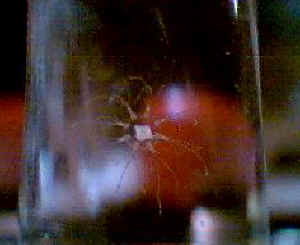 |
 |
Finicky feeding fish and unidentified polyps Hi, We are
working with a 20G tank, lots of live rock & live sand. Filtration:
Fluval 2+, protein skimmer, & sponge filter. Inhabitants: 2
seahorses (about 8 months), 1 mandarin (about 6 months), 1 sand sifting
star (about a month), 2 hermit crabs (forever =), & 3 feather
dusters (long time). Good water quality. 1 50/50 or daylight
fluorescent tube (can't remember) running about 12 hours/day. There
are lots of nice things growing on the live rock: some coral, some
macro-algae, some teeny feather dusters. There also seems to be some
bristle worms, bad news I think. << Bristle worms are great. But
I would definitely remove the sand sifting star. They can deplete and
devour micro fauna, and you happen to have chosen fish that need that
fauna. >> Lately some little clear things have grown all over the
live rock & even on the hermit crabs :-O they are about 1/4",
basically clear. They have short stems & waving arms. We thought
they might be feather dusters but they have no tube & stay out.
<< Hmmm, not sure. Probably still a worm. >> We then
thought anemone, but think the stem seems too long. We brought a small
piece of coral to the LFS with some sticking on it. They brought out a
microscope & looked very carefully at one of them that had detached
& was at the bottom of the bag. It was pulsing, they came up with
the verdict of Cassiopeidae (upside down jellyfish) polyps (baby
jellies they think). We looked over your *fab* site to see how to get
rid of them, but they look very much like hydroids in some pictures.
<< Not sure I would get rid of them. But if you do want to,
I'd be willing to bet many other common fish would eat them.
>> Will you please advise on whether these may be harmful to our
occupants and how to get rid of them if so? << I'll say not
harmful, so don't worry. The main concern is really feeding those
finicky fish. >> Thanks for all the help and for a great site!!!
Michael & Patty << Blundell >>
Jellyfish I was looking into my tank at my new Blue Linckia
Starfish (thank you for the advice by the way, he's doing great!)
and I saw a tiny (about 1mm) jellyfish swimming around my clownfish, it
must have come in with my live rock. I could tell that it is a
jellyfish because of the way it was moving; it's really quite
unmistakable. What should I do with it? Will it harm my fish? Do you
have any idea how large it will get? If I decide to get rid of it what
can I do with it, I don't want to kill it. Thanks, Elizabeth
<Liz, jellyfish are not reef safe and most are toxic to people. Take
it back to the store and see if they want it. I don't believe you
would want to set up a small tank for it and furnish it the necessary
plankton it needs to survive at this stage. James (Salty
Dog)><<Uhh, one millimeter... just ignore it... they too shall
pass. RMF>>
|
|

